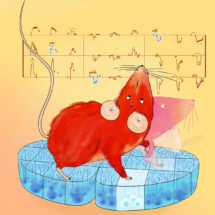
While reaching for our morning cup of coffee, we experience the movement of our arm as continuous and smooth. It is natural then to think that the representation of these movements in our brain would also be continuous and smooth. Studying how such target-oriented movements are controlled, Marco Tripodi’s group in the LMB’s Neurobiology Division reveal for the first time that the representation of these actions in the brain is instead granular and discontinuous.
When studying the organisation and function of neural circuits in the brain, scientists identify different groups of neurons by looking at several characteristics. Laura Masullo and Letizia Mariotti, two researchers in Marco’s group, investigated gene expression in mice in an area of the brain called superior colliculus, known to be important for controlling goal-oriented movements, to identify any genes specifically expressed in its neurons. They found a gene called Pitx2, which is solely expressed in a subgroup of neurons in the superior colliculus. Interestingly, when looking at Pitx2 expression locally, they were able to see that cells expressing this gene were clustered into modules that arranged in a grid pattern that was tiling the whole of the brain region.
To study how these modules of Pitx2-expressing neurons direct movement, Laura and Letizia used optogenetic techniques, which involved activating a specific set of neurons by shining light at them through an optic fibre. They observed that activation of each module directed a specific type of head movement. Through the use of sensor boards that measure the angle of tilt or movement in different directions, such as those used in planes or in mobile phones, the team were able to precisely measure the extent and angle of head movement. They found that switching on the neurons in any particular module made the mouse move its head by a fixed amount and in a fixed direction.
Of course, neither mice nor we move through a series of staccato positions. Therefore, combinations of modules must be activated for more fine control of directionality of movement. If each module on the grid in the superior colliculus is a key on a piano and each head position is an individual note, then the smooth movements we make while interacting with the world around us are the music orchestrated through the combinations of discrete notes in chords and melody. In this study, Marco’s group has not only revealed the organisation of such a keyboard, for the first time, but has also paved the way for greater understanding of how the music is played to allow our brains to direct motor control so that we can interact with the environment and drink our morning coffee.
The work was funded by the MRC, ERC, and ERA-NET NEURON.
Further references:
Genetically defined functional modules for spatial orienting in the mouse superior colliculus. Masullo, L., Mariotti, L., Alexandre, N., Freire-Pritchett, P., Boulanger, J., Tripodi, M. Current Biology 29: 1-14
Marco’s group page
Previous Insight on Research: Three-dimensional representation of motor space in the brain